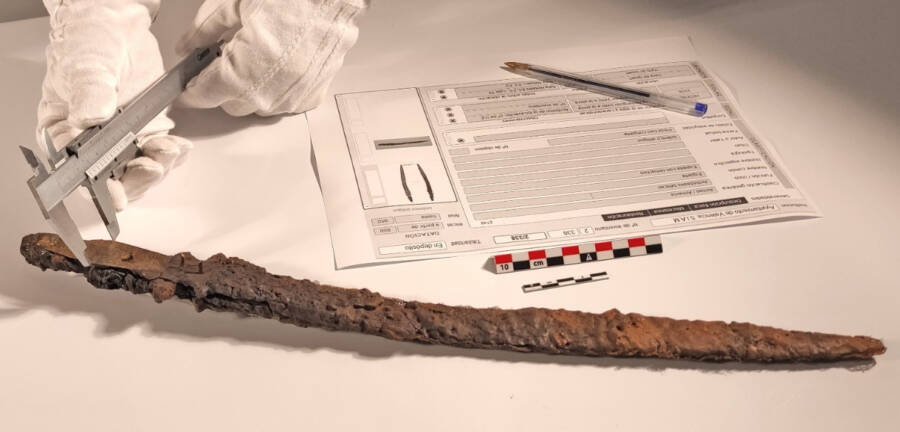First discovered in 1994, the origins of the mysterious "Excalibur" sword found in Valencia, Spain had eluded researchers for 30 years.

Servici D’Arqueologia de L’ajuntament de València SIAMThe blade of the “Islamic Excalibur” sword recovered from an archaeological site in Valencia in 1994.
In 1994, archaeologists working at a site in Valencia, Spain discovered an iron sword sticking straight up out of the ground. They dubbed the sword “Excalibur” due to its similarity to the mythical blade from the British legends of King Arthur, but until recently, it was unclear how old the sword truly was or who once wielded it.
Now, however, a team of archaeologists from the Archaeology Service (SIAM) of the Valencia City Council has traced the sword’s origins back to the 10th century, meaning it is more than 1,000 years old.
Given that Valencia had been occupied by numerous cultures throughout its long history, this detail goes a long way in helping to explain the significance of this remarkably well-preserved sword — which is itself a rarity, since the region’s soil typically makes conservation difficult.
Uncovering The Origins Of The “Islamic Excalibur”
As the Spanish publication Horta Noticias reports, the sword’s age places it firmly within the Islamic period in Spain, which lasted from 711 to 1492 C.E.
It is also the first Islamic-era sword to be discovered in the Valencia region, which was known during the time as Al-Andalus.
Based on the size of the sword and the absence of a hand guard, it is likely that it was meant to be used by a mounted swordsman in the Andalusian Caliphal era.

Servici D’Arqueologia de L’ajuntament de València SIAMThe handle of the ancient sword, plated in bronze.
The sword is roughly 18 inches in length, with a bronze plate hilt and slightly curved blade, somewhat reminiscent of Visigoth swords — which had, until now, been a source of some confusion regarding its age.
It was the sediment layers in which the sword was found that allowed archaeologists to date it to the Islamic period, finally putting the mystery of its origin to rest.

Servici D’Arqueologia de L’ajuntament de València SIAMArchaeologists from the SIAM analyzing the sword dubbed the “Excalibur de Roc Chabàs.”
The Islamic period in Valencia was immediately preceded by the rule of the Visigoths, a Germanic people who were greatly influential in Europe during the Early Middle Ages, which could explain the similarities in the sword’s design to blades of that era.
Only one other comparable specimen has been discovered so far, during excavations in the ancient Caliphal city of Medina Azahara.
“This sword has a unique design that gives it great archaeological and heritage value, so we have a new treasure in this Islamic Excalibur and a historical legacy of ancient Balansiya,” said José Luis Moreno, the councilor for cultural action in Valencia.
Ongoing Efforts To Catalog Historic Artifacts In The Region
Since its discovery, the sword has been restored and is now part of an ongoing analysis of metal objects ranging from the Roman era to the late medieval period.
The study is being undertaken by archaeologist José Miguel Osuna, thanks to an annual archaeology scholarship organized by the Valencia City Council.

Servici D’Arqueologia de L’ajuntament de València SIAMArchaeologists are working to catalog a variety of metal objects ranging from the Roman era to the medieval period.
“Thanks to the archaeology scholarship convened by the Valencia City Council, the archaeologist José Miguel Osuna is carrying out a detailed study of analysis of metallic objects that go from Roman times to the late medieval period and where a new and exceptional find has come to light, which we have called the Excalibur de Roc Chabàs to be very similar to the legendary sword of King Arthur,” Moreno said.
The ongoing study also coincides with the department’s 75th anniversary, which will culminate in an exhibition at the city’s town hall near the end of the summer.
After reading about the origins of this ancient sword, discover more about the region’s history by learning about the Reconquista, the centuries-long battle for control of the Iberian Peninsula. Then, read about the khopesh, another unique ancient sword that helped forge the Egyptian empire.





